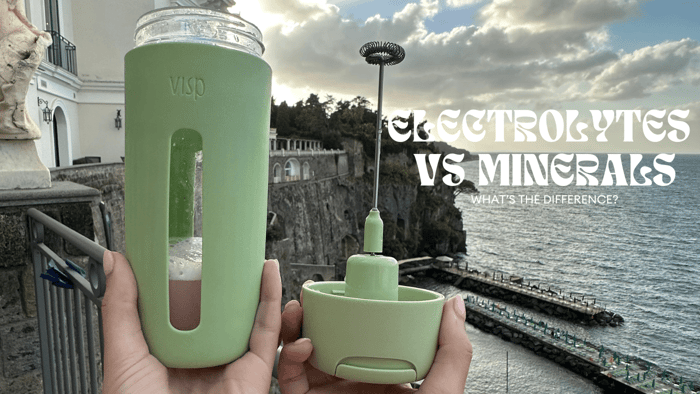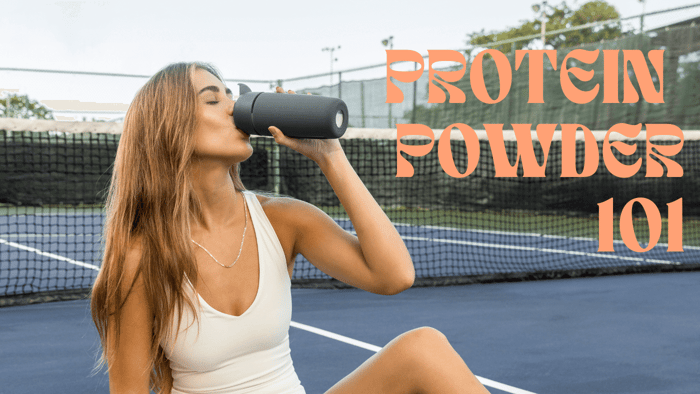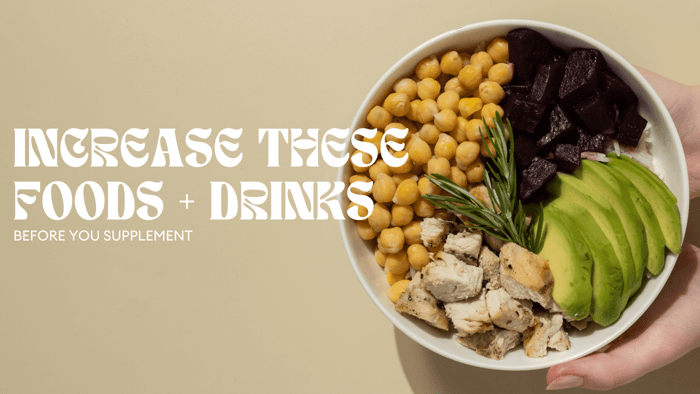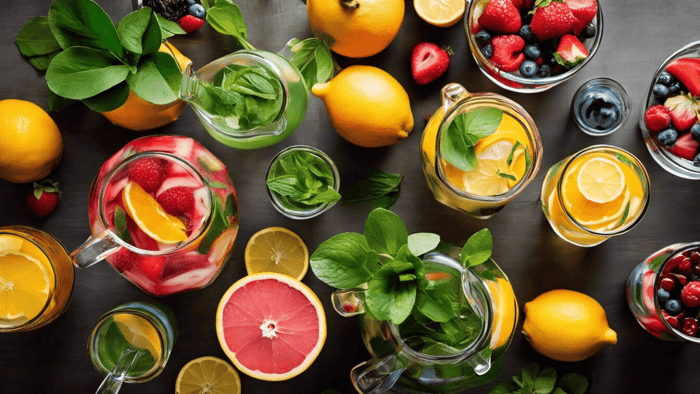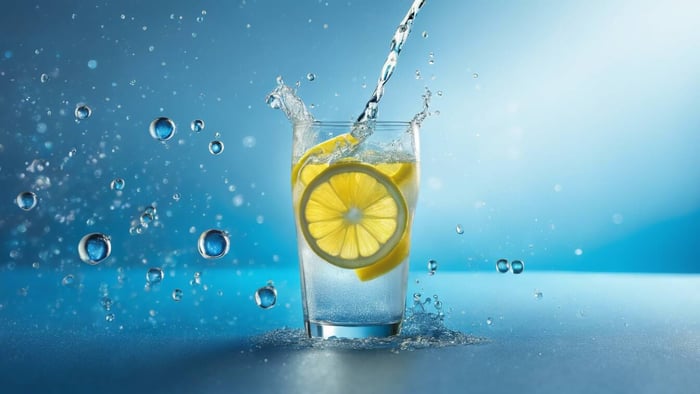Electrolytes vs. Minerals: What’s the Difference?
And Why the Elixir Mixer is Perfect for Making Nutrient-Packed Drinks
Modern wellness has us talking about everything from superfoods to adaptogens, yet one of the most fundamental elements of a healthy body can get lost in the shuffle: minerals—and specifically, the subcategory of minerals we often refer to as electrolytes. A stroll down any supplement aisle will reveal numerous powders, capsules, and drinks touting the benefits of electrolytes or essential minerals. But what’s the real difference between the two? And how can you incorporate them into your daily life in a convenient, delicious way?
In this comprehensive guide, we’ll explore what makes electrolytes and minerals unique, why you need both for optimal wellness, and how to seamlessly integrate them into your routine. We’ll also take a look at why a tool like the Elixir Mixer is perfect for whipping up elixirs and blends that take advantage of these critical nutrients.
1. Minerals 101
What Are Minerals?
Minerals are inorganic substances found in soil, water, and living organisms. They’re critical micronutrients our bodies require for a wide range of processes, from building strong bones to supporting proper hormone function. Unlike vitamins, which are organic compounds produced by plants and animals, minerals are derived from the earth itself.
Categories of Minerals
Scientists and nutritionists often categorize minerals into two groups:
- Macro Minerals (Major Minerals): These are required in larger amounts. Examples include calcium, phosphorus, magnesium, sodium, potassium, and chloride.
- Trace Minerals (Microminerals): Needed in smaller amounts but still vital. Common trace minerals include iron, zinc, copper, selenium, manganese, iodine, and fluoride.
Why Minerals Matter
Minerals serve structural, regulatory, and chemical roles. For instance:
- Calcium: Essential for bone health and also plays a role in nerve signaling.
- Magnesium: Critical for muscle and nerve function, as well as hundreds of enzymatic reactions.
- Iron: Integral to red blood cell formation and oxygen transport.
When you think of “minerals,” you might picture those that build bones and fortify blood. And you’d be right—but that’s only half the story. Some of these same minerals also perform electrolyte functions in the body, which we’ll explore next.
2. Electrolytes Explained
Defining Electrolytes
Electrolytes are substances that produce an electrically conducting solution when dissolved in water. In more straightforward terms, they’re ions—charged particles—that help transmit signals throughout the body. Common electrolytes include sodium, potassium, chloride, calcium, magnesium, and sometimes phosphate and bicarbonate.
What Makes an Electrolyte?
Not all minerals are electrolytes, but many electrolytes are minerals. When you place table salt (sodium chloride) in water, it dissociates into sodium (Na+) and chloride (Cl-) ions—this is how it becomes an electrolyte. Similarly, magnesium (Mg^{2+}) or calcium (Ca^{2+}) ions can circulate in the bloodstream, conducting electrical impulses.
Electrolyte Functions
Electrolytes are crucial for:
- Muscle Contraction: Without sufficient potassium, magnesium, and calcium, muscles struggle to contract and relax properly.
- Nerve Impulse Conduction: Sodium, potassium, and chloride help transmit signals along nerves.
- pH Balance: Bicarbonate helps maintain optimal acidity/alkalinity in bodily fluids.
- Hydration: Sodium and potassium help regulate fluid distribution, ensuring cells neither bloat nor dehydrate.
In essence, electrolytes keep the communication lines open throughout your body, coordinating everything from heartbeat to digestion.
3. Where the Overlap Lies
So, are electrolytes just a special kind of mineral? In many cases, yes. Sodium, potassium, calcium, and magnesium are prime examples. You’ll see them categorized both as minerals (because they’re inorganic elements needed by the body) and as electrolytes (because they carry an electrical charge in solution).
While all electrolytes are minerals or compounds containing mineral ions, not all minerals function as electrolytes. For example, iron is essential for oxygen transport but doesn’t primarily act as an electrolyte in the same way that sodium or potassium does.
4. Why We Need Both
Minerals Beyond Electrolyte Status
Some minerals—particularly trace minerals—don’t contribute significantly to electrical conductivity but remain essential for other bodily functions (like enzyme function, hormone balance, and immune support). Think of zinc for wound healing or selenium for antioxidant defense.
Electrolytes for Daily Function
Electrolytes like sodium and potassium keep us hydrated at a cellular level and maintain nerve and muscle function. Low levels can lead to fatigue, cramps, or irregular heartbeat; excess levels can strain the kidneys and affect blood pressure.
Balancing Act
Neglecting either category can result in deficiencies, which might appear as anything from brittle nails and hair loss (linked to low iron or zinc) to muscle cramps and dizzy spells (linked to low sodium or potassium). Thus, ensuring a balanced intake of both broad-spectrum minerals and targeted electrolytes is crucial.
5. Common Sources of Minerals and Electrolytes
Whole Foods
- Fruits (e.g., bananas and oranges for potassium)
- Vegetables (e.g., leafy greens for magnesium, cruciferous veggies for calcium)
- Legumes (e.g., beans and lentils for iron, magnesium)
- Nuts & Seeds (e.g., pumpkin seeds for zinc, almonds for magnesium)
- Whole Grains (e.g., brown rice, oats)
- Dairy or Fortified Plant Milks (calcium, sometimes fortified with vitamin D)
Beverages
- Coconut Water: Known for its potassium content.
- Bone Broth: Can offer minerals like calcium, magnesium, and phosphorus.
- Electrolyte Drinks: Commercial sports drinks or more natural versions (e.g., homemade with citrus juice, salt, and a sweetener).
Supplementation
- Mineral Complexes: Can include full-spectrum minerals, often in chelated form for better absorption.
- Electrolyte Powders/Tablets: Quick and easy way to replenish after a sweat session or illness.
6. Signs of Imbalance
Mineral Deficiencies
- Calcium: Muscle spasms, bone weakness, osteoporosis in the long term.
- Magnesium: Fatigue, muscle cramps, headaches, anxiety-like symptoms.
- Iron: Anemia, fatigue, weakened immune response.
Electrolyte Imbalances
- Low Sodium (Hyponatremia): Headache, nausea, confusion, or severe fatigue.
- Low Potassium (Hypokalemia): Muscle cramps, weakness, abnormal heart rhythms.
- Low Magnesium (Hypomagnesemia): Similar to general magnesium deficiency—twitches, cramping, and mood disturbances.
Often, these deficiencies or imbalances occur due to poor dietary intake, excessive losses (through sweat, diarrhea, or vomiting), or certain medical conditions. If you suspect a significant issue, consult a healthcare professional for testing and personalized guidance.
7. Practical Ways to Incorporate Electrolytes and Minerals
Boosted Water
Make your water more functional by adding a pinch of sea salt (for sodium and trace minerals), plus a squeeze of lemon (for potassium and vitamin C). This transforms plain water into a mild electrolyte drink.Infused Smoothies
Toss a handful of spinach (magnesium, potassium), chia seeds (calcium, iron), and banana (potassium) into your blender. You’ll get a broad spectrum of essential minerals in one go.Balanced Snacks
Keep nuts (almonds, cashews) or seeds (pumpkin seeds) nearby for a quick magnesium or zinc boost. Pair them with a piece of fruit to support electrolyte balance.Mineral-Rich Soups and Broths
Homemade soups—especially with homemade bone broth—can deliver collagen (for joint support) and minerals like calcium and magnesium. Add nutrient-dense vegetables for an extra layer of vitamins and trace minerals.Elixir Supplements
Many brands now offer powdered mineral complexes or electrolyte blends you can stir into water. Look for options low in sugar and high in natural ingredients.Mind Your Overall Diet
A balanced approach—fruits, vegetables, whole grains, and quality protein—tends to maintain healthy levels of minerals and electrolytes without the need for extreme supplementation.
8. Why the Elixir Mixer is Essential
Now, you may be thinking: “All this talk about powders and electrolytes—how do I actually whip them up without leaving clumps at the bottom of my glass?” That’s where the Elixir Mixer shines. Here’s why:
Clump-Free Consistency
Adding powdery electrolyte mixes or mineral supplements to water, smoothies, or tea can result in gritty residue. The Elixir Mixer’s efficient swirling mechanism disperses particles evenly, so every sip delivers the intended nutritional punch.Time Saver
Instead of manually stirring or shaking a closed container (risking leaks or lumps), a quick blend with the Elixir Mixer yields a velvety-smooth drink in seconds—ideal for busy mornings or on-the-go lifestyles.Flavor Enhancement
Proper blending ensures the sweeteners, salts, and other flavoring agents are uniformly distributed, so you don’t get an overly salty gulp at the bottom or a powdery layer on top.Versatility
The Elixir Mixer isn’t just for electrolyte powder. Use it for protein shakes, green superfood blends, or any functional beverage containing powdered supplements. One tool, many uses.Mindful Ritual
Watching your beverage swirl can even be part of a mini “wellness break,” infusing a moment of calm into your daily routine. This bit of mindfulness can be especially beneficial if you’re trying to keep stress down—since stress itself can deplete certain minerals, like magnesium.
In short, if you’re serious about leveling up your hydration and mineral intake, the Elixir Mixer is a perfect partner for blending nutrient-dense elixirs.
9. Sample Recipes
A) Daily Electrolyte “Spa Water”
Ingredients
- 16 oz (about 500 ml) of filtered water
- Juice from 1/2 a lemon (potassium + vitamin C)
- A small pinch of pink Himalayan salt or sea salt (sodium + trace minerals)
- 1/2 teaspoon raw honey or a few drops of stevia (optional, for sweetness)
Directions
- Fill your Elixir Mixer with water.
- Add lemon juice, salt, and sweetener.
- Use the Elixir Mixer for a few seconds to thoroughly combine.
- Enjoy immediately or store in a thermos to sip throughout the morning.
Benefits: Gently replenishes sodium and potassium, plus trace elements. Perfect for starting the day or recovering after light exercise.
B) Green Mineral Latte
Ingredients
- 1 cup (about 240 ml) unsweetened almond or oat milk
- 1 teaspoon spirulina or chlorella powder (rich in trace minerals)
- 1/2 teaspoon magnesium powder (optional, check supplement guidelines)
- 1 teaspoon coconut oil (healthy fats)
- Stevia or raw honey to taste
- A pinch of cinnamon (optional, for flavor)
Directions
- Warm the milk on low heat—avoid boiling.
- Transfer warm milk to your Elixir Mixer.
- Add spirulina, magnesium powder, and coconut oil.
- Blend with the Elixir Mixer until smooth and frothy.
- Sweeten to taste and dust with cinnamon if desired.
Benefits: High in chlorophyll, trace minerals, and magnesium. This beverage can support energy, muscle relaxation, and overall vitality.
C) Post-Workout Cacao Electrolyte Shake
Ingredients
- 1 cup (about 240 ml) coconut water (potassium)
- 1/2 cup (about 120 ml) almond or oat milk
- 1 scoop chocolate whey or plant-based protein (optional but great for muscle recovery)
- 1 tablespoon cacao powder (magnesium + antioxidants)
- A pinch of pink salt (sodium + trace minerals)
- 1/2 frozen banana (thickens + potassium)
Directions
- Place all ingredients in your Elixir Mixer.
- Use the Elixir Mixer to combine thoroughly.
- Serve immediately to replenish fluids, electrolytes, and protein post-workout.
Benefits: Delivers a balanced ratio of carbs, protein, and electrolytes to help restore muscle glycogen, aid repair, and keep you hydrated after exercise.
10. Final Thoughts
Electrolytes and minerals play overlapping yet distinct roles in keeping your body’s daily functions running smoothly. Minerals form the structural and regulatory backbone of numerous physiological processes, while electrolytes handle the electrical signaling that drives muscle contractions, nerve impulses, and fluid balance. Together, they’re vital for maintaining everything from strong bones to steady energy.
In a world where quick-fix beverages and processed snacks dominate many diets, cultivating awareness around your electrolyte and mineral intake can be a game-changer for your health. By choosing whole-food-based drinks, soups, or smoothies—and occasionally supplementing with powders or tablets—you can steer clear of the pitfalls of mineral and electrolyte deficiencies.
Of course, none of this matters if you can’t seamlessly mix these nutritional powerhouses into a palatable drink. That’s where the Elixir Mixer comes in. With its swift, clump-busting action, you can effortlessly combine powders, sweeteners, and other ingredients into smooth, delicious elixirs—freeing you up to focus on the joys of feeling truly nourished.
Whether you’re adding a pinch of salt to your morning water or blending a post-workout mineral shake, remember that consistency is key. Aim to keep your intake of electrolytes and minerals balanced across the day, and pair it with good lifestyle habits like regular exercise, quality sleep, and mindful stress management. Over time, you’ll likely notice improvements in energy, mental clarity, and overall resilience—living proof that something as simple as “just the right blend” of essential nutrients can make a lasting difference in how you feel.
So, grab your Elixir Mixer, stock up on mineral-rich ingredients, and start experimenting. Your body—and your taste buds—will thank you.
References / Further Reading
- National Institutes of Health (NIH): Office of Dietary Supplements.
- Journal of the American College of Nutrition on electrolyte balance.
- Clinical research on magnesium’s effects in muscle and nerve function.
(Always consult with a healthcare professional before making significant changes to your diet, especially if you have underlying medical conditions or take medication.)
Cheers to Balanced Minerals, Electrolytes, and the Perfectly Blended Elixirs that Keep You Thriving!
